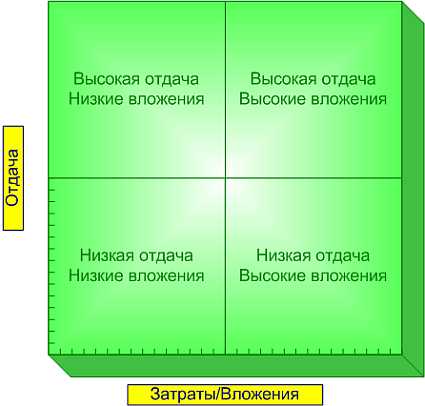Today I came across an interesting article about Parkinson's law and how you can look at your tasks and efforts from such an angle as to evaluate them by their impact, and not by rather abstract terms of importance and urgency.
Take a look at this diagram:

Instead of the traditional importance and urgency, investments and returns are used in the quadrants. By looking at what you are doing, you will be able to understand which of your to-do list in the past and present brings you the maximum return with minimal investment, and what is wasting time without giving anything in return. Of course, we are all smart and in general could do without such a scheme, but ... it is clear, it is simplified and it helps.
But how to use it, you ask. Spread your typical tasks across the selected quadrants, as investments (because we are talking about cases) it is worth considering your time and effort, i.e. complexity. As a return – satisfaction, which is the final form of any activity, even spending "vulgar" money.
As a result, you will most likely see that your tasks will not be an exception and will be distributed according to the Pareto Law. Most likely, 80% of all tasks bring a small return: routine work with accounts, documents, performing small but seemingly mandatory tasks. The remaining 20% are tasks that bring you 80% of the pleasures and satisfaction of life. Moreover, as you can see their graphics – not all of them require large investments of time and effort.
Now you just have to make a simple conclusion – the optimization of "profit" is to reduce the number of "unprofitable", but costly activities and increase those that, with minimal effort, bring maximum benefit.
Everything is trivial, no new truths.
The 80/20 Rule And The Importance Of Value [ James ]